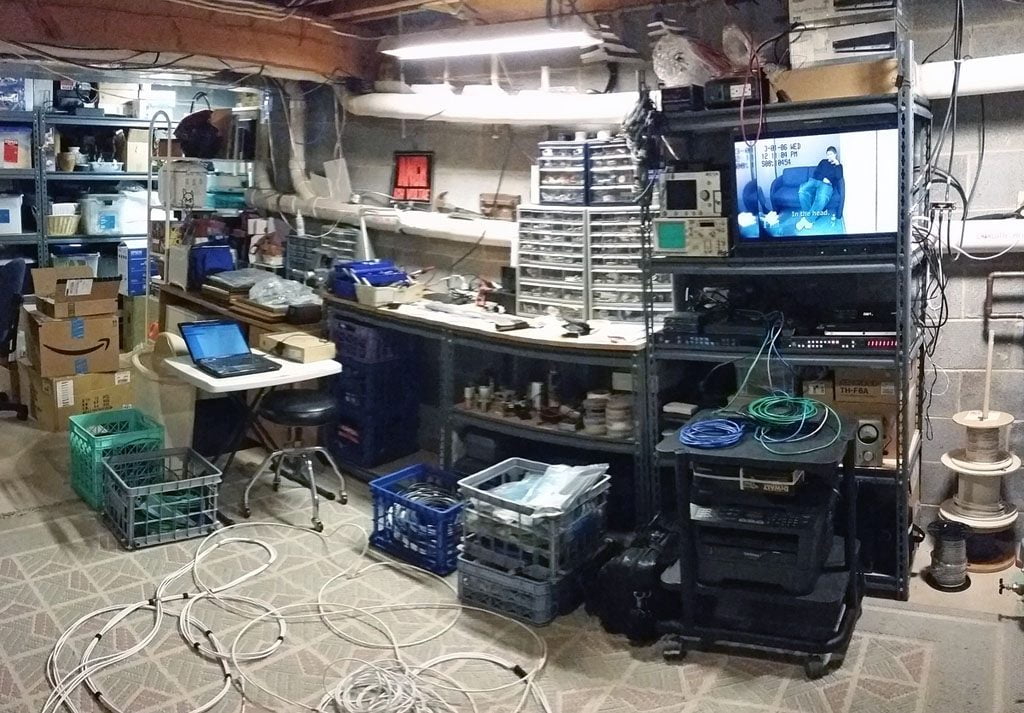 A few years ago, readers may recall my on-going battles with Comcast to fix a service reliability issue. I had asked from the start that the ‘drop’ – the underground RG-6 coaxial cable running from the sidewalk to my house – be replaced. I suspected the cable’s jacket had been compromised with moisture over time.
A few years ago, readers may recall my on-going battles with Comcast to fix a service reliability issue. I had asked from the start that the ‘drop’ – the underground RG-6 coaxial cable running from the sidewalk to my house – be replaced. I suspected the cable’s jacket had been compromised with moisture over time.
Several visits from Comcast later (plus two modem upgrades), they finally did just that. Lo and behold, the underground cable had been spliced at some point with a barrel and simply covered with dirt – no insulating tape or waterproofing applied.
In the middle of all this fun and games, I received an offer from Comcast to upgrade to their X1 platform. That meant two new set-top boxes – one with a DVR function (not quite an accurate description, as the “DVR” is actually a cloud server), and one ‘basic’ box without DVR access.
So I went ahead and replaced everything. My network speeds had also gone up considerably along the way, and I also had a new 802.11ac channel bonding modem with 2.4 and 5 GHz WiFi connections. Life was good, right?
Well, it was – until last fall, when I started experiencing intermittent dropouts of my Internet service. They came and went randomly and could last as long as 15 minutes before service was restored.
“Here we go again!” I thought to myself as several rounds of diagnostics ensued. Was it the drop to the street? Nope, my spectrum analyzer showed a full spectrum of strong, level QAM carriers all the way up to 700 MHz. Was it a modem problem? I switched out the 802.11ac Arris modem I originally received as part of my upgraded street drop for a Technicolor model.
That didn’t solve anything, either. I looked at all of the coaxial lines running through my house and also checked out the Cat 6 cables I had run after we installed hardwood floors. Was it possible that energy was coupling from the bundle of category cables into the modem? Not likely, as that arrangement had been working well for over a year.
Finally, I got a Comcast technician to stop by the house and we started sweeping all of the coaxial lines for noise. Lo and behold, the line that feeds my family room and master bedroom boxes had noise around 26-29 MHz, which could have affected the upstream signal from the modem.
Temporarily running an RG-6 cable directly from my X1 DVR to the noise meter showed a clean spectrum, so I got to work running a new cable connection back to the two-way splitter in my basement. After dressing the wires and reconnecting everything, I figured I was out of the woods.
Except I wasn’t. Not long after, the intermittent drop-out started again. In the middle of critical projects, I took to using my Samsung Galaxy as a temporary WiFi hot spot to wait out things out. I rebooted the modem numerous times and was at wit’s end.
Calls to Comcast revealed there weren’t any service outages. Was it RFI from the category cables, by some crazy chance? I replaced the bundle with a single piece of Cat 6 STP (shielded) wire – drains soldered at both ends – and installed an 8-port 1 Gb switch to feed all of my networked devices behind my family room TV.
That didn’t fix the problem. ARRGGGH! What could it be? The noise HAD to be coming through the coaxial cable – but from where?
After pondering my next move, I decided to connect my spectrum analyzer to each coaxial cable run and look very carefully for noise and unwanted energy around 25 – 30 MHz. Connected to my X1 DVR, I saw nothing. It was as clean as a whistle.

The guilty party under test. A short piece of coax runs from the CABLE IN connector directly to my spectrum analyzer.
However, connected to my ‘basic’ X1 box in the bedroom, I saw the noise floor briefly jump from about -85 dBm to -80 dBm – and this was happening about every two seconds, as regular as a clock. Well, this looks promising! So I switched on “persistence” mode on the analyzer, which would allow whatever momentary spikes of energy to remain visible on screen.
What I saw next was jaw-dropping. High-energy spurious RF carriers dotted the spectrum, starting as low as 6 MHz and running all the way up past 50 MHz. Expanding my scan width to 100 MHz, I found even more of these little buggers – some of them as strong as -64 dBm. (For reference, the QAM carriers in my system are around -40 dBm.)
I expanded the upper limit of my spectral scan to 200, 300, and 400 MHz, only to find RF spikes everywhere. Yikes! I ran upstairs, unplugged the X1 ‘basic’ box, brought it down to my lab, and connected the CABLE IN port directly to the input of my spectrum analyzer.

These RF spikes were enough cause for alarm, so I expanded my spectrum scan.

Things were looking even worse at 100 MHz!

What a mess! And some of the spikes were only 20 dB down from my QAM carriers, like the one at about 300 MHz.
And there was the answer. The X1 box (manufactured by Samsung) had apparently been generating broadband RF interference every 2 seconds for several months, and it was coupling back through the RF input into my system. When my modem sent an upstream request to the Comcast server that happened to coincide with one of these “bursts” of RFI, the connection to the server was lost…and our Internet was out. DOH!
A trip to the Comcast “store” (that’s a generous description as it’s more like a crowded reception room) to return the offending box revealed that design isn’t used any more. Instead, a small (about 6” x 6”) flat terminal was exchanged for my RFI generator. This new STB had just four ports – power, HDMI, RF input, and USB – and now syncs as a slave to my X1 DVR, emulating all of its functions.
In the meantime, our Internet service is now as clean as a whistle and drop-out free. Once again, some thorough detective work and analytical thinking solved what had become a frustrating problem with no apparent resolution.
I’ll discuss this fun episode from my life in more detail during my RF and wireless class at InfoComm this coming June. Come on by, and learn more about troubleshooting RF interference problems in the real world! (And keep an eye on your cable box while you’re at it…)
The post Now You See It…Now You Don’t appeared first on HDTVexpert.
[“Source-hdtvmagazine”]










